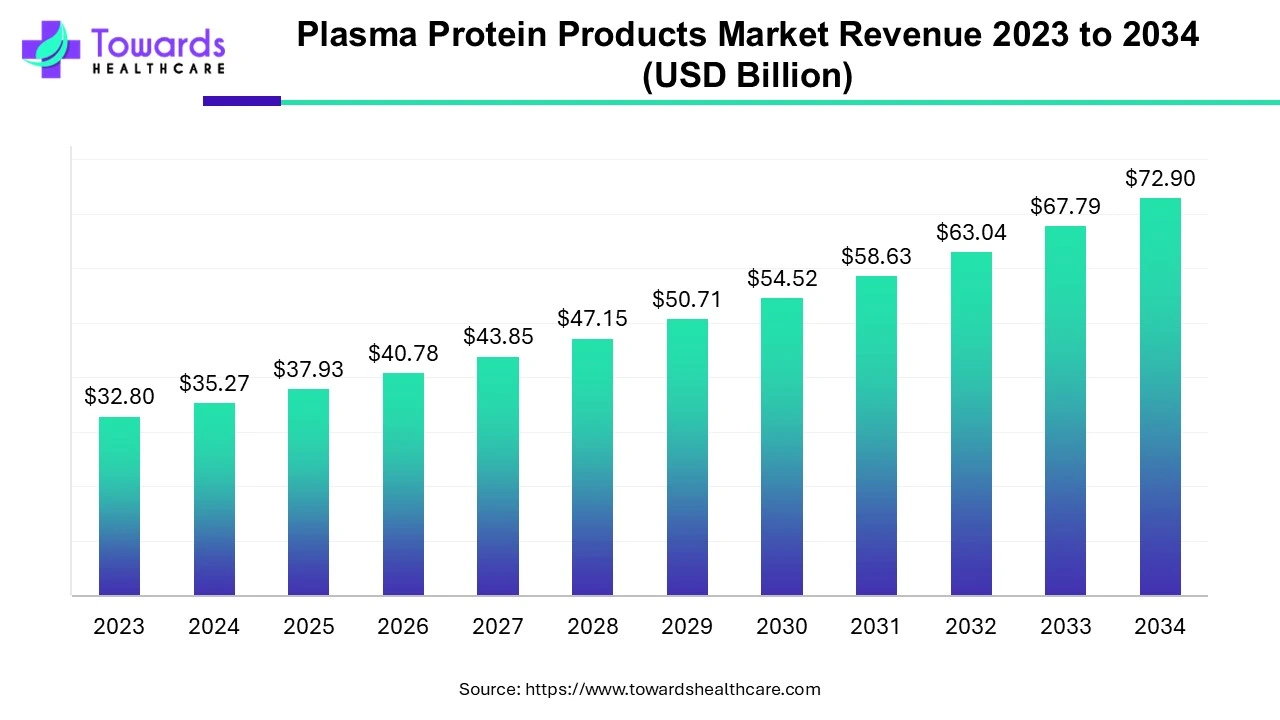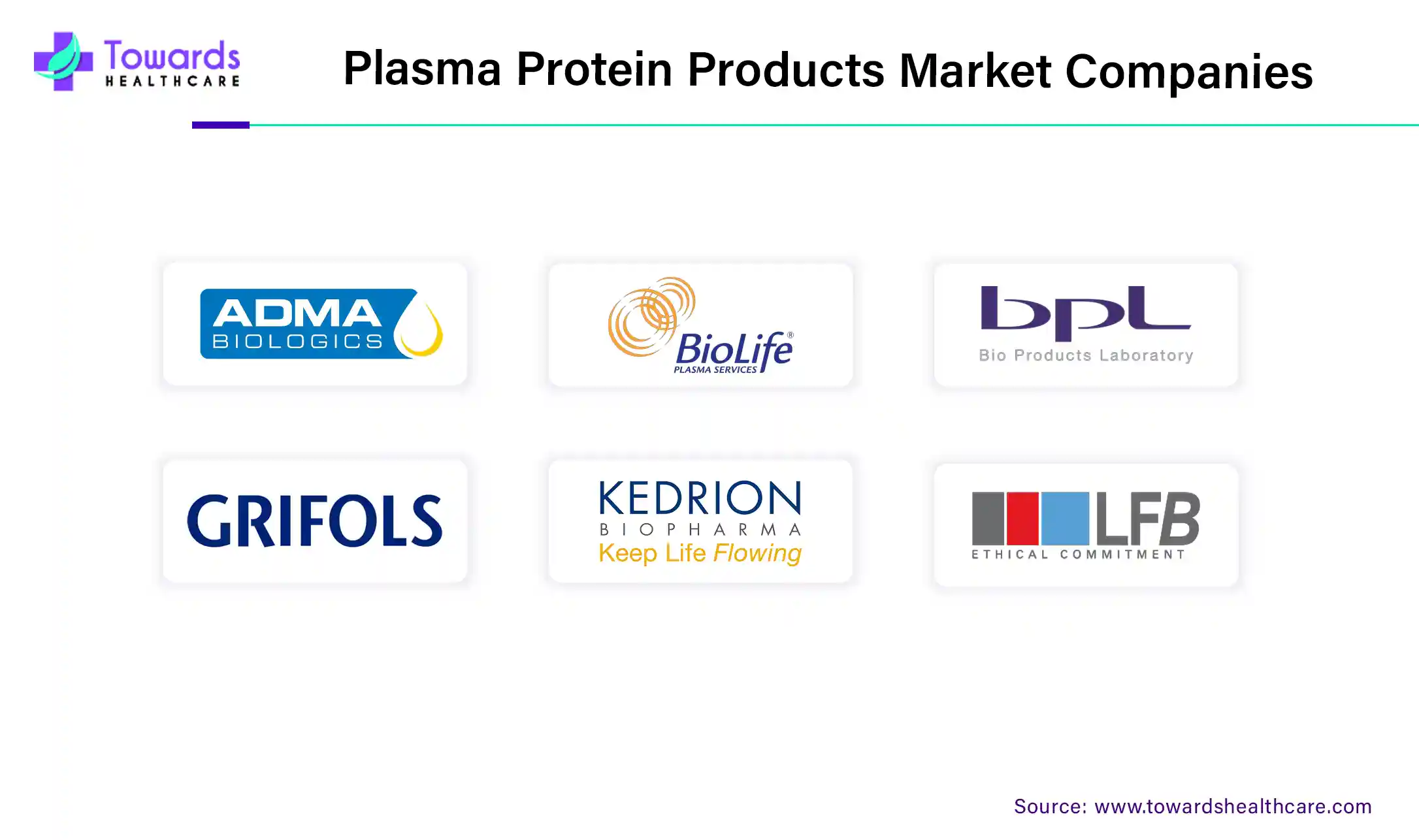March 2025


Principal Consultant

Reviewed By
The plasma protein products market was estimated at US$ 32.8 billion in 2023 and is projected to grow to US$ 72.9 billion by 2034, rising at a compound annual growth rate (CAGR) of 7.53% from 2024 to 2034. The increasing incidences of hematological and autoimmune disorders, growing research and development and increasing awareness about plasma donation drive the market.

Plasma is a major component of the blood constituting about 55% of its overall content. Plasma protein products are the products that are extracted from blood plasma. Large volumes of plasma are manipulated/processed and manufactured into small amounts of finished products through a process called fractionation. Examples of plasma protein products include albumin, coagulation factors, fibrinolytic proteins, immunoglobulin, clotting factors, etc.
The rising incidences of hematological and immunological disorders increase the demand for plasma protein products. Plasma products are used to treat several disorders such as bleeding disorders when a patient is deficient in one or multiple clotting factors, life-threatening trauma/hemorrhages, and clinically significant coagulation deficiencies. Additionally, increasing awareness for blood donations and evolving fractionation techniques augment market growth.
Researchers demonstrated an alternative to the conventional fractionation technique, a recombinant technique to produce plasma proteins in laboratories to fill the gap between demand and supply. A recombinant protein is a protein produced through recombinant DNA technology which encompasses the insertion of a genetically modified protein gene into the cell of a host organism. The recombinant technology can produce and commercialize complex plasma proteins for human therapeutic applications. The sophisticated investigation of alternative cell lines, upgraded cell culture techniques, and the creation of alternative expression technologies like transgenic animals potentiate the development of novel methods. In addition, the growing research and development activities and increasing investments promote the market. The increasing investments in biotechnology R&D globally and public-private partnerships drive innovations in recombinant technology for producing plasma protein products.
The major challenge of the market is the shortage of sufficient plasma for generating plasma protein products. The demand for plasma protein products is abruptly rising due to several reasons. However, there is a lack of sufficient plasma supply from blood donors globally, leading to an inadequate demand-to-supply ratio. Moreover, the lack of or disturbance in supply chain management also acts as a major restraint for the market.
North America held a dominant presence in the plasma protein products market in 2023. The rising incidences of rare and chronic disorders, advanced healthcare infrastructure, state-of-the-art research and development facilities, and the presence of key players drive the market. Around 50 million people are suffering from autoimmune disorders in the US. It is estimated that around 300,000 individuals in Canada have an inherited bleeding disorder.
Major market players such as Grifols, CSL, ADMA Biologics, and BioLife hold a major share of the market. Several government and non-government organizations such as the Food and Drug Administration of the US, Health Canada, and Canadian Blood Services of Canada, regulate plasma proteins to ensure they meet international standards of safety and efficacy. The increasing awareness of blood donations and plasma donations also augments market growth.
Asia-Pacific is projected to host the fastest-growing plasma protein products market in the coming years. The rising geriatric population, increasing incidences of hematological and immunological disorders, upgrading infrastructure, and favorable government policies drive the market. Around 13,343 people in Japan and 65,000 people in China are reported to have hemophilia requiring treatment with plasma proteins. In addition, it is estimated that more than 31 million in China have one or more autoimmune disorders. In India, over 450 rare disorders exist, affecting approximately 80-100 million individuals. Also, as of September 2023, China reports around 780,000 rare disease cases.
Furthermore, manufacturing demand in the region drives market growth. India completely depends on the import of either full-finished plasma protein products or bulk plasma. However, government initiatives like “Make in India” promote the development of plasma products in India. China is the largest consumer and manufacturer of plasma proteins globally. In 2023, China exported 20,908 shipments of plasma in 62 countries.
By type, the immunoglobulin segment held the largest share of the plasma protein products market in 2023. Immunoglobulins are plasma proteins that are injected intravenously to treat several autoimmune, infectious, and idiopathic disorders. The increasing incidences of these disorders, especially after the COVID-19 pandemic, potentiate the segment growth. According to a 2023 study of 22 million people conducted by the University of Oxford, one in every ten individuals gets affected by an autoimmune disorder in the UK.
The albumin segment is projected to expand rapidly in the plasma protein products market in the coming years. Albumin is a plasma protein used to treat or prevent shock following serious injury, bleeding, surgery, or burns by increasing the volume of blood plasma. The rising incidences of these disorders, demand for natural product therapeutics, and expanded use of albumin augment the segment growth.
By application, the hospital segment accounted for a considerable share of the plasma protein products market in 2023. The demand for hospitals is attributed to the increasing number of patients with critical bleeding emergencies, autoimmune disorders, and chronic disorders. Hospitals have favorable infrastructure and capital investment for adequate storing and administrating plasma proteins in humans. In addition, the availability of trained personnel and favorable reimbursement policies boost the segment's growth.

By Type
By Application
By Region
March 2025
February 2025
February 2025
January 2025